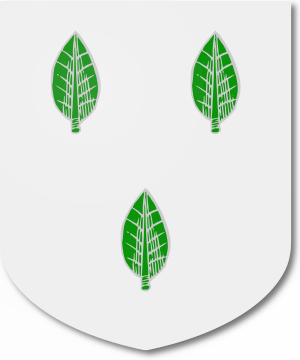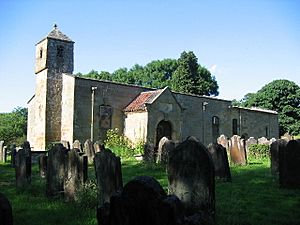Sir David Foulis, 1st Baronet facts for kids
Sir David Foulis (died 1642) was a Scottish nobleman and politician. He played an important role in the courts of King James VI of Scotland and later King James I of England.
Contents
Early Life and Family Connections
David Foulis was the third son of James Foulis of Colinton. His mother was Agnes Heriot. His family had many important people, including his great-grandfather, Sir James Foulis, who was a judge. His brothers included James Foulis of Colinton and George Foulis, who was a goldsmith and worked at the Royal Mint. His sister, Margaret, married a lawyer named Thomas Hamilton. His uncle, Thomas Foulis, was also a famous goldsmith and helped the king with money.
The Foulis family lived in a place called Old Colinton House. David's mother, Agnes Heriot, passed away in 1593 and was buried in Colinton Parish Church. She was likely the sister of George Heriot, a well-known merchant from Edinburgh.
From 1594 onwards, David Foulis became very involved in politics. Many of his letters, which tell us about his work, have been published.
Working for the King
David Foulis often traveled to London. His main job was to help King James VI receive money, called an "annuity" or "subsidy," from Queen Elizabeth I of England. He became friends with Anthony Bacon, who worked for the Earl of Essex. Foulis even called the Earl of Essex "Plato" in his letters.
In July 1594, Foulis received a large sum of money, £4,000, for King James VI. His uncle, Thomas Foulis, who was a royal money manager, kept track of how this money was spent. David Foulis himself received £1,000 (Scots money) to cover his travel costs to London.
Foulis also wrote about important events, like the arrival of ambassadors for the baptism of Prince Henry, King James's son, in 1594. He also reported on discussions about Princess Augusta of Denmark possibly marrying Count Maurice.
After the baptism, Foulis traveled with King James VI to the north of Scotland. He wrote to the Earl of Essex that the king had to pawn his jewels to get £2,000 for this trip. The king was determined to destroy any places where Catholic Mass was held. Foulis reported seeing Huntly Castle being torn down while the Countess of Huntly watched. He also saw destruction at Old Slains Castle.
In July 1595, King James VI gave Foulis a diamond ring worth 200 crowns. Foulis was to give this ring to someone in London, likely the Earl of Essex. His mission was to ask for more money for King James. He also needed to discuss issues along the border with England and congratulate Queen Elizabeth on the Earl of Essex.
When he returned to Scotland, Foulis wrote to the Earl of Essex. He told him that King James thought highly of Queen Elizabeth. Foulis had not given the Earl's letter to the Chancellor of Scotland, John Maitland, because he was ill. Foulis hoped the Chancellor would get better and form a strong alliance with the Earl of Mar. However, Maitland passed away soon after, which changed Foulis's plans.
Challenges and Delays
In March 1596, Foulis was sent to London again with letters from the king. He was given 100 crowns and a promise of a monthly payment. However, King James received an anonymous letter criticizing Foulis. The letter suggested that important English figures were working against the king's interests.
That year, Queen Elizabeth delayed giving money to Foulis for King James. This was because of an incident where Walter Scott of Buccleuch had rescued a man named Kinmont Willie from Carlisle Castle. In July 1596, Walter Stewart of Blantyre wrote to Foulis, suggesting he should return home if Queen Elizabeth's attitude did not improve.
Foulis wrote to King James on July 20, saying his discussions with the queen were going well. He used a tennis phrase, "I praise God the ball is yet aloft," meaning things were still in play and he hoped for a good outcome.
King James wrote back, urging Foulis to keep asking for the money. He reminded Foulis of earlier agreements. Another person, James Hudson, wrote to Sir Robert Cecil that Foulis was "perplexed with fear" about the situation. Hudson suggested that Scotland's treasury was now doing well. He thought holding back the money would only hurt the king and his money managers. David Foulis finally received £3,000 in September. In October, he was ready to leave London with many trunks filled with goods for the Scottish royal household.
Important Writings
In February 1598, an English diplomat reported that Foulis had asked a printer to publish a Latin book. This book, written by Walter Quinn, argued that King James VI should be Queen Elizabeth's successor. The printer was hesitant to print it, and no copies of this book are known to exist today. It is also thought that Foulis might have secretly brought other books from England to be printed in Edinburgh. These books also argued for James VI to become the next ruler.
Protecting the King's Reputation
In 1598, Foulis was an ambassador in England dealing with the "Valentine Thomas affair." A man named Valentine Thomas claimed that King James VI had asked him to assassinate Queen Elizabeth. This accusation could harm James's chances of becoming the next English king.
By February 24, King James was unhappy with Foulis's efforts. He felt Foulis had gone beyond his instructions and accepted a deal that did not fully clear the king's name. King James wrote to Queen Elizabeth about the potential damage to his reputation.
The English ambassador in Scotland, Robert Bowes, discussed Foulis's suitability for this important mission. He felt Foulis was too ordinary for such a serious matter. However, Sir Robert Ker spoke up for Foulis, trying to make Bowes think better of him.
Foulis was also asked to help in a legal case for George Bruce of Carnock. Bruce's ship had been forced to take on a group of African and Portuguese captives.
Court business in August was interrupted by a funeral. Later that month, Queen Elizabeth complained to Foulis about King James writing to the Earl of Tyrone. Foulis was also questioned about a Scottish embassy to Germany. This embassy was supposedly discussing Queen Elizabeth's likely death and support for James's claim to the English throne. There were also instructions for talks with Spain and the Pope, which King James claimed were fake. Foulis brought back a sapphire ring with Queen Elizabeth's portrait for Anne of Denmark to wear.
Richard Douglas, a letter writer, wrote to his uncle, who disliked Foulis. Douglas said Foulis was foolish and that King James had started to realize this. He thought Foulis would not be sent to England again. In August 1599, James Sempill went to London instead of Foulis.
In September 1599, Foulis had dinner at Colinton castle with his brother and an English adventurer. They watched the king hunting from the top of the tower. King James stopped to eat and spoke with the adventurer.
Foulis was in London again in December 1601. He wrote about some jewels and expressed his unhappiness with James Sempill.
Life in England
After Queen Elizabeth's death, King James sent Foulis to Sir Robert Cecil. Foulis came to England with King James in 1603. He was knighted on May 13, 1603. He received an honorary Master of Arts degree from Oxford University in 1605. In April 1606, he became a naturalized English citizen.
In 1607, Foulis and others received a special permission to make "alum" in Yorkshire. Alum was used in many industries. In 1609, he bought the large estates of Ingleby and Battersby. He was made a Baronet of England in 1619–20. He also worked as a "cofferer" (a financial officer) for both Prince Henry and Prince Charles.
In May 1610, Prince Henry sent Foulis to Bath with news about the assassination of King Henry IV of France. This news was for Frederick Ulrich, the Duke of Brunswick-Lüneburg, who then cut short his visit and returned to London. A record of the wages Foulis paid for Prince Charles's household in 1610 was published in 1802.
Sir David was highly favored by King James I. In 1614, he received a famous letter of advice to the king from Sir Robert Dudley, who was in Italy. In 1629, Foulis gave evidence about this document after it was found. Dudley also sent designs for warships to Foulis in 1612 and 1614. He hoped these ideas would help him gain favor with the king through the Earl of Somerset.
As a member of the Council of the North, Foulis disagreed with Thomas Wentworth's strong leadership. In July 1632, Foulis claimed that the council did not have parliamentary authority. He also accused Wentworth of misusing public money. Wentworth strongly denied the accusation. Foulis asked King Charles I for protection from Wentworth's anger. He also offered to help the people of Yorkshire become more cooperative.
However, Foulis was removed from the council. He was ordered to pay £5,000 to the Crown and £3,000 to Wentworth. He was sent to Fleet Prison in 1633 because he could not pay. He stayed there until the Long Parliament released him on March 16, 1641.
Foulis appeared as a witness against Strafford (Thomas Wentworth) at his trial in 1641. Sir David Foulis passed away at Ingleby in 1642.
Family Life
Sir David Foulis was married to Cordelia Fleetwood. She passed away in August 1631 and was buried at Ingleby. They had five sons and three daughters.
Their oldest son, Sir Henry, became the second Baronet. He was fined £500 when his father was punished in 1633. He was a military leader in 1643. He married Mary, the daughter of Sir Thomas Layton. Their son was Henry Foulis. Another son, Robert, was a colonel in the army.
One daughter, Anne Foulis, married a doctor named George Purves in 1639.
The youngest daughter was Elizabeth Foulis, born in 1622. There was a family story that Elizabeth Foulis had a son with King Louis XIII of France when she was a maid of honor in France. This son or his descendant was said to have moved to England and changed his name to Folds. However, Elizabeth Foulis's will, proved in 1696, shows she died unmarried and does not mention any illegitimate son.
In 1899, a woman named Eliza Ann Foulds tried to get a special family crest based on this story. She claimed to be a descendant of Elizabeth Foulis's supposed son with Louis XIII. This claim was not fully proven. However, a compromise crest was designed for her, including a fleur-de-lys (a French symbol), bay leaves from the Foulis family crest, and the White Rose of Yorkshire.
The Foulis baronetcy ended when the eighth Baronet, Rev. Sir Henry Foulis, died on October 7, 1876.
Through his grandson, the third Baronet, Sir David Foulis is an ancestor of the actor Benedict Cumberbatch.




